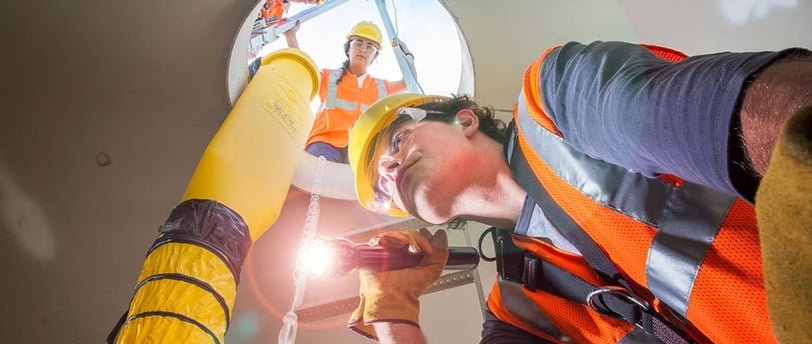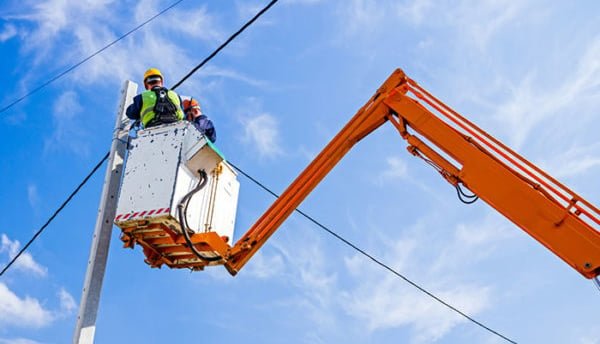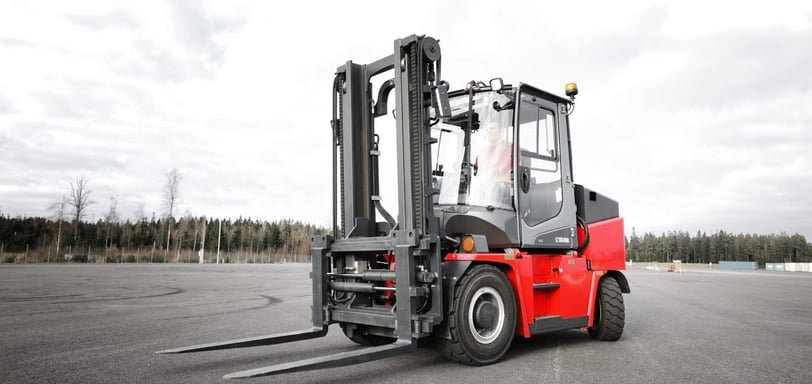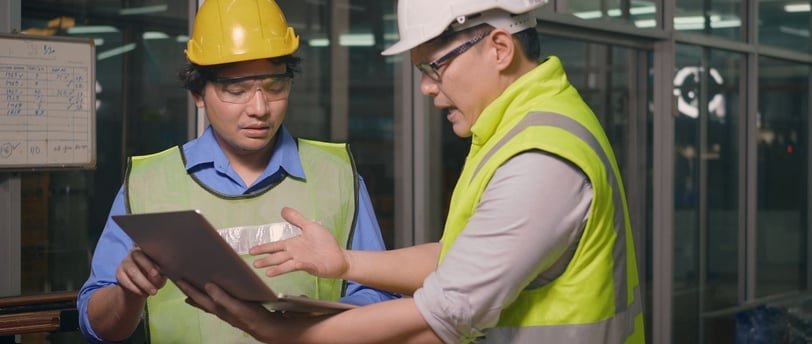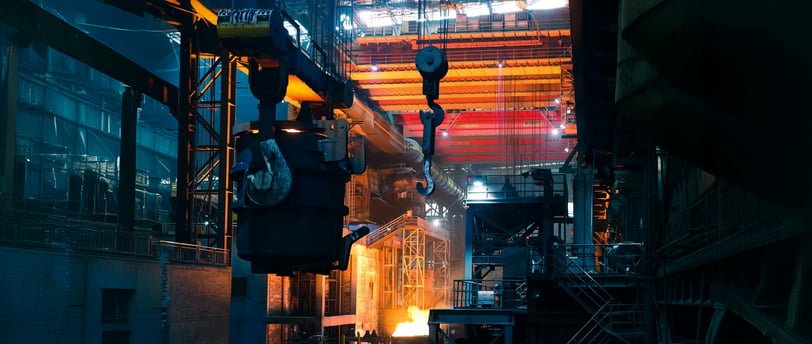Confined spaces pose unique and often deadly risks in workplaces across Ontario. This guide breaks down what qualifies as a confined space, the hazards involved, and how Ontario’s OHSA Regulation 632/05 governs safe entry, training, and rescue procedures to protect workers and ensure compliance.
Learn how to stay compliant with Ontario’s OHSA Regulation 632/05 for confined spaces. Discover key hazards, training, and safe entry procedures.
What Is a Confined Space?
In Ontario, a confined space isn’t defined by its size—it’s defined by its danger.
Under Ontario Regulation 632/05 – Confined Spaces, a space is considered confined if it meets all three of these conditions:
-
Not designed for continuous human occupancy: These areas are meant for short-term access for inspection, cleaning, repair, or maintenance.
-
Restricted entry or exit: Limited openings make entry and rescue more difficult.
-
Potential for atmospheric hazards: Toxic gases, oxygen deficiency, or flammable vapours can accumulate rapidly.
Common examples include tanks, silos, sewers, pipelines, crawl spaces, and underground vaults—places where a small mistake can quickly turn fatal.
Why Confined Spaces Are So Dangerous
Despite appearing harmless, confined spaces can create immediate life-threatening conditions.
The main risks fall into three categories:
1. Atmospheric Hazards
Toxic gases such as hydrogen sulfide, carbon monoxide, or methane can cause unconsciousness or death within minutes.
Oxygen deficiency from chemical reactions or displacement can lead to asphyxiation, while oxygen enrichment increases the risk of explosion.
2. Physical Hazards
These include engulfment by liquids or solids, slips and falls, entrapment, electrical hazards, and exposure to heat or cold.
3. Isolation Risks
Communication barriers often delay rescue efforts. Workers inside may be unable to signal distress or receive help quickly enough.
How the OHSA Protects Ontario Workers
Recognizing the severity of these risks, the Occupational Health and Safety Act (OHSA) and Ontario Regulation 632/05 provide a strict legal framework for employers and supervisors.
Before any worker enters a confined space, several safety controls must be in place, including:
-
Hazard Assessment: Identify atmospheric and physical hazards, and determine control measures.
-
Written Confined Space Program: A documented plan—developed in consultation with the Joint Health and Safety Committee—covering safe entry, monitoring, and rescue procedures.
-
Entry Permits: Every entry must have a valid, supervisor-approved permit listing all precautions, hazards, PPE, and authorized personnel.
Training and Competency: The Foundation of Confined Space Safety
No one should ever enter a confined space without proper training and certification.
Under Ontario Regulation 632/05, employers must ensure that all workers who enter, act as attendants, or perform rescue operations are adequately trained and competent in:
-
Recognizing confined space hazards
-
Following entry and exit procedures
-
Using personal protective equipment (PPE) and gas monitoring devices
-
Executing emergency and rescue protocols
Training should be hands-on and task-specific, reflecting the actual environments and hazards workers face.
Partnering with a certified training provider like Achieve Safety ensures your workforce understands not just the rules, but the reasons behind them building both compliance and confidence.
Atmospheric Testing: Know Before You Enter
Atmospheric testing isn’t optional—it’s the first line of defence.
Before anyone enters, the air inside a confined space must be tested for:
-
Oxygen concentration (too little causes asphyxiation, too much increases explosion risk)
-
Flammable gases or vapours
-
Toxic contaminants such as carbon monoxide or hydrogen sulfide
If unsafe conditions exist, entry is prohibited until corrective actions—like ventilation—make the atmosphere safe.
Continuous monitoring may be required throughout the job, especially in dynamic environments.
Ventilation: Controlling the Invisible Threat
Proper ventilation maintains safe air quality inside confined spaces by controlling heat, fumes, vapours, and airborne contaminants.
Mechanical ventilation systems (like exhaust fans or air movers) are often used to circulate clean air.
The goal is simple: keep atmospheric conditions safe and stable throughout the entire job.
Emergency Preparedness: Rescue Plans Save Lives
Even the best prevention measures can’t eliminate every risk. That’s why the law requires every employer to have a written rescue plan in place before entry begins.
A compliant plan includes:
-
Designated rescue personnel trained and equipped for confined space emergencies
-
Accessible rescue equipment, including retrieval systems and breathing apparatus
-
Clear communication protocols between entrants, attendants, and rescue teams
A well-practiced rescue plan can mean the difference between life and death when seconds matter.
Shared Responsibility: Safety Is Everyone’s Job
Workplace safety isn’t a one-sided duty.
-
Employers must provide proper training, supervision, and safe procedures.
-
Supervisors must enforce regulations and ensure workers follow the confined space program.
-
Workers must never enter a confined space without a valid entry permit, functioning monitoring equipment, and required PPE.
If at any point a worker doubts the safety of the space or procedure, they have the right to refuse unsafe work under the OHSA—and are legally protected when doing so.
Creating a Safer Future with Achieve Safety
Confined space hazards are serious, but they’re preventable.
By investing in OHSA-compliant safety trainings, proactive hazard assessment, and a safety-first culture, Ontario businesses can drastically reduce incidents and protect their teams.
At Achieve Safety, we specialize in Confined Space Training and Awareness programs that align with Ontario Regulation 632/05 and the Occupational Health and Safety Act (OHSA).
Our certified trainers help your team recognize hazards, perform safe entries, and respond effectively in emergencies—ensuring compliance, confidence, and control.
👉 Learn more about our Confined Space Training & Awareness Ontario course and take the next step toward a safer, fully compliant workplace.
FAQs – Confined Space Safety Ontario
Q1. What qualifies as a confined space in Ontario?
Under Ontario Regulation 632/05, a confined space is a fully or partially enclosed area that is not designed for continuous human occupancy, has restricted entry or exit, and contains—or may contain—atmospheric or other hazards that could harm workers.
Q2. Why is confined space work so dangerous?
Confined spaces can contain toxic gases, oxygen-deficient air, and flammable vapours that can lead to asphyxiation or explosion. Limited access also makes rescue difficult. Physical hazards such as engulfment, falls, or electrical risks further increase the danger.
Q3. What does Ontario Regulation 632/05 require from employers?
The regulation mandates a hazard assessment, a written confined space program, valid entry permits, worker training, atmospheric testing, ventilation, and a rescue plan. Employers must consult their joint health and safety committee or a worker representative when developing these procedures.
Q4. Do workers need special training to enter confined spaces?
Yes. Only trained and authorized workers may enter. Training must include hazard recognition, safe work practices, equipment use, and emergency response procedures. Ontario employers often meet this requirement through Achieve Safety’s Confined Space Training & Awareness course.
Q5. What is a confined space entry permit?
An entry permit is a written document that lists the identified hazards, protective measures, personal protective equipment (PPE), atmospheric test results, and emergency contacts. It must be signed by a supervisor and displayed near the entry point for the duration of the work.
Q6. How is atmospheric testing performed before entry?
Testing is done using calibrated gas-monitoring equipment to check oxygen levels, flammable vapours, and toxic gases. Entry is allowed only when readings confirm the air is safe, and continuous monitoring may be required if conditions could change.
Q7. What should a confined space rescue plan include?
A rescue plan must outline rescue procedures, name trained rescue personnel, list available rescue equipment, and establish communication protocols. Rescue teams must practice regularly to ensure a rapid and effective response in emergencies.
Q8. How can Ontario businesses stay compliant with confined space regulations?
Businesses can stay compliant by maintaining up-to-date training records, reviewing confined space programs annually, performing regular atmospheric testing, and ensuring every entry follows OHSA and Regulation 632/05 requirements. Partnering with a certified provider like Achieve Safety ensures ongoing compliance and worker protection.

